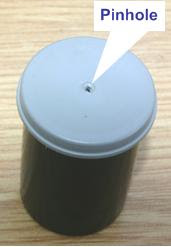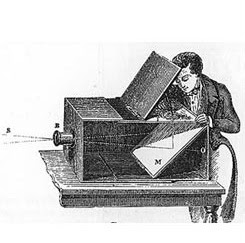Pinhole photography is making an image without a lens. A small needle sized hole replaces the lens. Light passes through the perforation in the foil; an image is formed in the film canister.

 Roughly what you will be making.
Roughly what you will be making. No one in our class tried the round end.
No one in our class tried the round end.try using the round end of the canister
Pinhole cameras come in all sizes, yours will be small but some are large, very large! The image your camera will produce will be roughly a 2x2 square, a recent World’s record camera was created in an airplane hanger creating an image 28 x108 feet long. Cameras have been made of fruit, in a loaf of bread, in a persons mouth, but most commonly are made out of oatmeal or shoe boxes. Basically a pinhole camera is a box, with a tiny hole at one end and film or photographic paper at the other.

 World's largest pinhole image- converted airplane hangar produces 28-by-108 foot black-and-white image
World's largest pinhole image- converted airplane hangar produces 28-by-108 foot black-and-white image
 The worlds smallest pinhole images- Justin Quinnell
The worlds smallest pinhole images- Justin Quinnell'SmileyCam' pinhole camera
Building your own camera can be a great learning experience. Making pictures with a camera you have made yourself out of simple materials is a way to understand photography at a very basic level. In fine art photography the pinhole camera is just an imaging device with its advantages and disadvantages. It has unique characteristics and surprising results. By trial, error, and using your imagination the camera has amazing potential.
Here are some images from other pinhole film canisters:

Animals
 The only thing cooler than a pinhole image... is a pinhole image of a bike
The only thing cooler than a pinhole image... is a pinhole image of a bike or a zoombie
or a zoombieHISTORY BEFORE THE PINHOLE CAMERA
Camera = Latin for “room”
Obscura = Latin for “dark”
Obscura = Latin for “dark”
"Who would believe that so small a space could contain the image of
all the universe? O mighty process! What talent can avail to
penetrate a nature such as these? What tongue will it be that can
unfold so great a wonder? Verily, none! This it is that guides the
human discourse to the considering of divine things. Here the
figures, here the colors, here all the images of every part of the
universe are contracted to a point. O what a point is so marvelous!"
--Leonardo Da Vinci's comments on the "Camera Obscura" (Dark Room), or what we today call the pinhole camera.
 1725 - Leonardo da Vinci gave a clear description of the Camera Obscura in the 16th century.
1725 - Leonardo da Vinci gave a clear description of the Camera Obscura in the 16th century.How the Camera Obscura works:
How to make a Camera Obscura:

Other Camera Obscuras:
French inventor Joseph Nicéphore Niépce uses a camera obscura.
Note to self: remember Niepce, we'll get back to him.
Note to self: remember Niepce, we'll get back to him.

 Until the early 1800's Camera Obscura was only used to aid drawing (artist could trace the outline of the image on a canvas hung on the wall) and was considered quite significant in the development of proto-photography.
Until the early 1800's Camera Obscura was only used to aid drawing (artist could trace the outline of the image on a canvas hung on the wall) and was considered quite significant in the development of proto-photography.Camera Lucida
In the years before the announcement of the first photographic processes in 1839, artists who wished to make a quick record of a scene with the correct prospective used a Camera Lucida.The original design of the camera lucida was published by William Hyde Wollaston (1766-1828) in 1807

Pinhole Camera
 A pinhole camera is a very simple camera with no lens and a single very small aperture. Simply explained, it is a light-proof box with a single hole in one side. Light from a scene passes through this single point and projects an inverted image on the opposite side of the box. Cameras using small apertures, and the human eye in bright light both act like a pinhole camera.
A pinhole camera is a very simple camera with no lens and a single very small aperture. Simply explained, it is a light-proof box with a single hole in one side. Light from a scene passes through this single point and projects an inverted image on the opposite side of the box. Cameras using small apertures, and the human eye in bright light both act like a pinhole camera.The smaller the hole, the sharper the image, but the dimmer the projected image. Optimally, the size of the aperture should be 1/100 or less of the distance between it and the screen.
A pinhole camera's shutter is usually manually operated because of the lengthy exposure times, and consists of a flap of some light-proof material to cover and uncover the pinhole. Typical exposures range from 5 seconds to hours and sometimes days.













the info about the pin hole camera was really informative.. the images too were interesting..
ReplyDelete